Low-Cost Real-Time Water Level Monitoring Network for Falling Water River Watershed: A Case Study
Abstract
:1. Introduction
2. Materials and Methods
2.1. Case Study
2.2. Methodology
2.2.1. Assembly of Low-Cost Real-Time Water Level Sensor Prototype
- Micro-controller: Based on these criteria, a sensor prototype was developed that included a Particle Electron LTE micro-controller platform. It is the main component of the sensor. The Particle Electron micro-controller platform follows an open-source design. It includes a STM32F205RGT6 ARM Cortex-M3 micro-controller which operates at a rate of 120 MHz. It can be updated by utilizing OTA updates. The Electron stores variables to carry a regular operation by using 128 KB of RAM and 1 MB of Flash ROM. This micro-controller is built using a MAX17043 battery monitor, which can measure the energy spent by the IoT node. The Particle Electron LTE supports LTE Cat M1 using a cellular module called U-blox SARA-R410M [13], and it enables an IP connection. A cellular antenna is enclosed for the micro-controller to establish a link to a nearby cellular tower [14]. This micro-controller acts as the central processing unit of the sensor. It is programmable to communicate with other electronic devices that are connected to it, and send and receive data from them. It is powered by a 3.7 V 1800 mAH Lithium Ion Polymer (Li-Po) battery and also connected to a 6 V 3.5 W Solar Panel that serves as an auxilliary power supply to recharge the battery;
- Circuit Board: The micro-controller is plugged into a custom-built circuit board as seen in Figure 2. This acts as the central location, to which all the electronics and electrical components are connected. The next crucial component is the ultrasonic water level sensor (see the next item);
- Ultrasonic level sensor: The ultrasonic level sensor used for the prototype is a MaxBotix XL-MaxSonar-WRMA1 sensor [15]. It is a IP-67 rated sensor that emits acoustic waves at 42 kHz and receives the return signal. Using the time elapsed and the speed of sound, calculates the distance traveled by the waves. To measure the water level, the ultrasonic level sensor is placed vertically facing the surface of the water in the waterbody. There may be other strategies to measure water depth, such as affordable pressure transducers. In this study, an ultrasonic sensor was used because it is a non-contact measurement strategy and at any point in the measurement, the equipment would not interact with the fast moving waters or floating debris, hence it can function reliably during high flow conditions. The choice of this particular ultrasonic sensor was based on previous studies conducted by Refs. [8,9,10];
- Hardware Peripherals: All the components of the water sensor are placed within a IP67 rated plastic box (approximately 6 inch × 6 inch × 3.5 inch) manufactured by Bud Industries [18]. The wires coming out of the box and connecting the solar panel and the ultrasonic sensors go through a vented cable gland [19], as shown in Figure 2.
2.2.2. Field Testing of the Sensor Prototype
2.2.3. Sensor Deployment and Data Collection
2.2.4. Data Storage and Visualization
2.2.5. Comparative Analysis
3. Results and Discussion
3.1. Event-Based Comparison
3.2. Long-Term Comparison
3.2.1. Wilcoxon Signed-Rank Test
3.2.2. Loess Seasonal Decomposition
4. Summary
Author Contributions
Funding
Institutional Review Board Statement
Informed Consent Statement
Data Availability Statement
Acknowledgments
Conflicts of Interest
Abbreviations
| MDPI | Multidisciplinary Digital Publishing Institute |
| DOAJ | Directory of open access journals |
| TNTech | Tennessee Technological University |
| USGS | United States Geological Survey |
References
- Smith, A.B. U.S. Billion-Dollar Weather and Climate Disasters, 1980-Present; NCEI Accession 0209268; National Oceanic and Atmospheric Administration, National Centers for Environmental Information: Biloxi, MI, USA, 2020. [CrossRef]
- Špitalar, M.; Gourley, J.J.; Lutoff, C.; Kirstetter, P.E.; Brilly, M.; Carr, N. Analysis of flash flood parameters and human impacts in the US from 2006 to 2012. J. Hydrol. 2014, 519, 863–870. [Google Scholar] [CrossRef]
- USGS. USGS Streamgaging Network. 2022. Available online: https://www.usgs.gov/mission-areas/water-resources/science/usgs-streamgaging-network (accessed on 26 December 2022).
- Normand, A.E. U.S. Geological Survey (USGS) Streamgaging Network: Overview and Issues for Congress. 2020. Available online: https://crsreports.congress.gov/product/pdf/R/R45695 (accessed on 26 December 2022).
- Castillo-Effer, M.; Quintela, D.H.; Moreno, W.; Jordan, R.; Westhoff, W. Wireless Sensor Networks for Flash-Flood Alerting. In Proceedings of the Fifth IEEE International Caracas Conference on Devices, Circuits and Systems, Punta Cana, Dominican Republic, 3–5 November 2004; Volume 1, pp. 142–146. [Google Scholar]
- Zhang, Z.; Glaser, S.D.; Bales, R.C.; Conklin, M.; Rice, R.; Marks, D.G. Technical report: The design and evaluation of a basin-scale wireless sensor network for mountain hydrology. Water Resour. Res. 2017, 53, 4487–4498. [Google Scholar] [CrossRef]
- Zhang, D.; Heery, B.; O’Neil, M.; Little, S.; O’Connor, N.E.; Regan, F. A low-cost smart sensor network for catchment monitoring. Sensors 2019, 19, 2278. [Google Scholar] [CrossRef] [PubMed]
- Kerkez, B.; Gruden, C.; Lewis, M.; Montestruque, L.; Quigley, M.; Wong, B.; Bedig, A.; Kertesz, R.; Braun, T.; Cadwalader, O.; et al. Smarter stormwater systems. Environ. Sci. Technol. 2016, 50, 7267–7273. [Google Scholar] [CrossRef] [PubMed]
- Wong, B.P.; Kerkez, B. Real-time environmental sensor data: An application to water quality using web services. Environ. Model. Softw. 2016, 84, 505–517. [Google Scholar] [CrossRef]
- Mullapudi, A.; Bartos, M.; Wong, B.; Kerkez, B. Shaping Streamflow Using a Real-Time Stormwater Control Network. Sensors 2018, 18, 2259. [Google Scholar] [CrossRef] [PubMed]
- Homer, C.; Dewitz, J.; Yang, L.; Jin, S.; Danielson, P.; Xian, G.; Coulston, J.; Herold, N.; Wickham, J.; Megown, K. Completion of the 2011 National Land Cover Database for the conterminous United States–representing a decade of land cover change information. Photogramm. Eng. Remote Sens. 2015, 81, 345–354. [Google Scholar]
- After Flooding Deaths at Cummins Falls, NWS Ramps up Communication Efforts. 2022. Available online: https://www.tennessean.com/story/news/2017/08/17/after-flooding-deaths-cummins-falls-nws-ramps-up-communication-efforts/575550001/ (accessed on 1 December 2022).
- u blox. SARA-R4 Series LTE-M/NB-IoT/EGPRS Modules with Secure Cloud. 2023. Available online: https://www.u-blox.com/en/product/sara-r4-series (accessed on 26 December 2022).
- Trilles, S.; González-Pérez, A.; Zaragozí, B.; Huerta, J. Data on records of environmental phenomena using low-cost sensors in vineyard smallholdings. Data Brief 2020, 33, 106524. [Google Scholar] [CrossRef] [PubMed]
- MaxBotix. MB7092 XL-MaxSonar-WRMA1. 2023. Available online: https://maxbotix.com/products/mb7092 (accessed on 26 December 2022).
- Adafruit. Lithium Ion Battery-3.7 V 2000 mAh. 2023. Available online: https://www.adafruit.com/product/2011 (accessed on 26 December 2022).
- Systems, V. 3.5 Watt 6 Volt Solar Panel. 2023. Available online: https://voltaicsystems.com/3-5-watt-panel/ (accessed on 26 December 2022).
- Industries, B. PTQ-11046. 2023. Available online: https://www.digikey.com/en/products/detail/bud-industries/PTQ-11046/5291540 (accessed on 26 December 2022).
- Conta-Clip, I. 97741.1 Cablegland. 2023. Available online: https://www.digikey.com/en/products/detail/conta-clip-inc/97741-1/10205549 (accessed on 26 December 2022).
- Particle. Device Cloud: A Secure, Scalable, and Reliable Cloud Platform to Manage Your Fleet of IoT Devices. 2022. Available online: https://www.particle.io/device-cloud/ (accessed on 2 April 2022).
- United States Geological Survey. USGS 03423000 Falling Water River near Cookeville, TN. 2022. Available online: https://waterdata.usgs.gov/nwis/inventory?site_no=03423000 (accessed on 26 December 2022).
- Kerkez, B.; Daniels, M.; Graves, S.; Chandrasekar, V.; Keiser, K.; Martin, C.; Dye, M.; Maskey, M.; Vernon, F. Cloud Hosted Real-time Data Services for the Geosciences (CHORDS). Geosci. Data J. 2016, 3, 4–8. [Google Scholar] [CrossRef]
- Tennessee Technological University. Home-Grafana. 2022. Available online: https://chordsrtf.tntech.edu/ (accessed on 2 April 2022).
- Moriasi, D.N.; Gitau, M.W.; Pai, N.; Daggupati, P. Hydrologic and water quality models: Performance measures and evaluation criteria. Trans. ASABE 2015, 58, 1763–1785. [Google Scholar]
- Rosner, B.; Glynn, R.J.; Lee, M.L.T. The Wilcoxon signed rank test for paired comparisons of clustered data. Biometrics 2006, 62, 185–192. [Google Scholar] [CrossRef] [PubMed]
- Cleveland, R.B.; Cleveland, W.S.; McRae, J.E.; Terpenning, I. STL: A Seasonal-Trend Decomposition Procedure Based on Loess (with Discussion). J. Off. Stat. 1990, 6, 3–73. [Google Scholar]
- Wilcoxon, F. Individual Comparisons by Ranking Methods. Biom. Bull. 1945, 1, 80–83. [Google Scholar] [CrossRef]
- USGS. Falling Water River near Cookeville, TN. 2023. Available online: https://waterdata.usgs.gov/monitoring-location/03423000/#parameterCode=00065&startDT=2021-03-26&endDT=2021-03-30, (accessed on 26 December 2022).
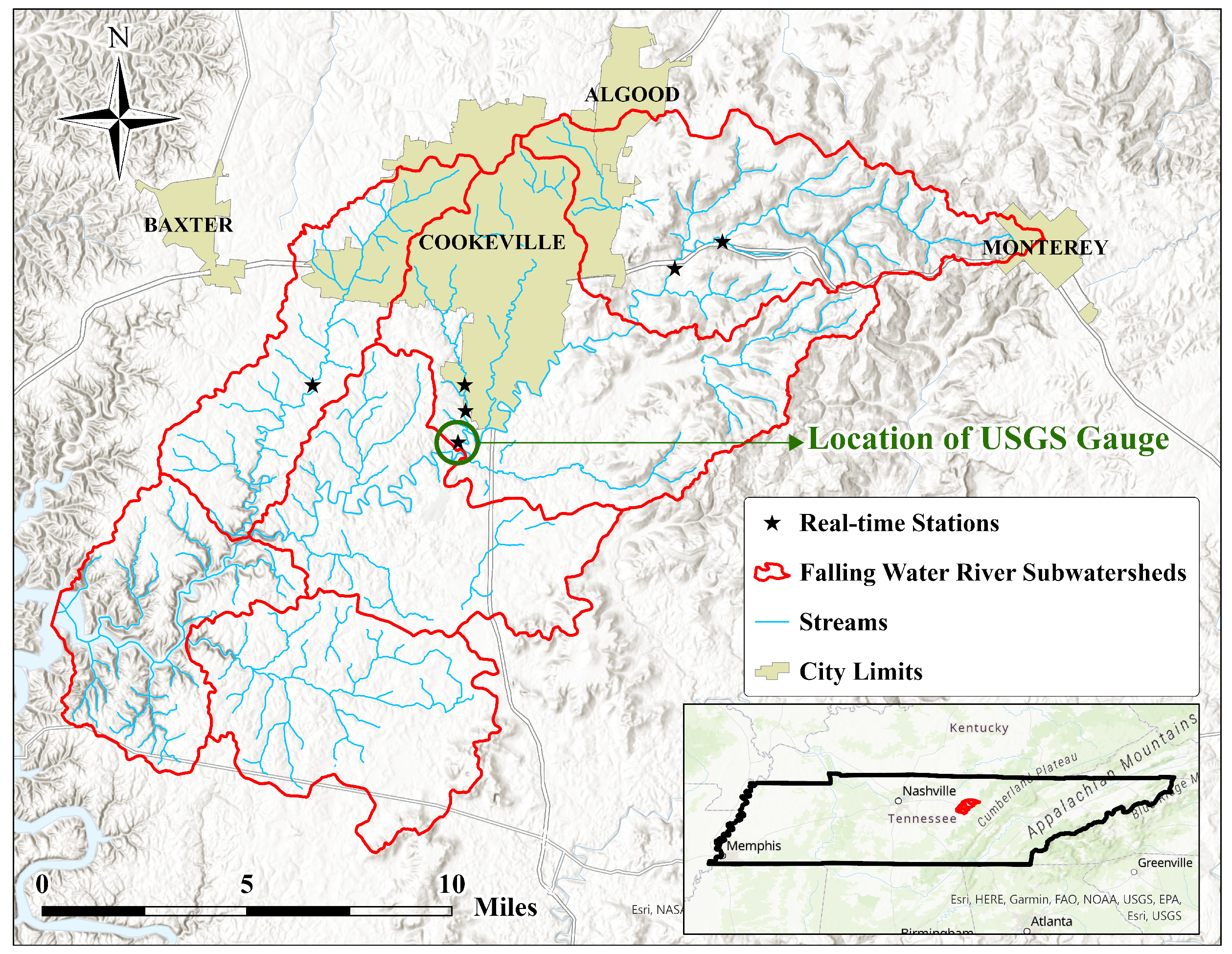
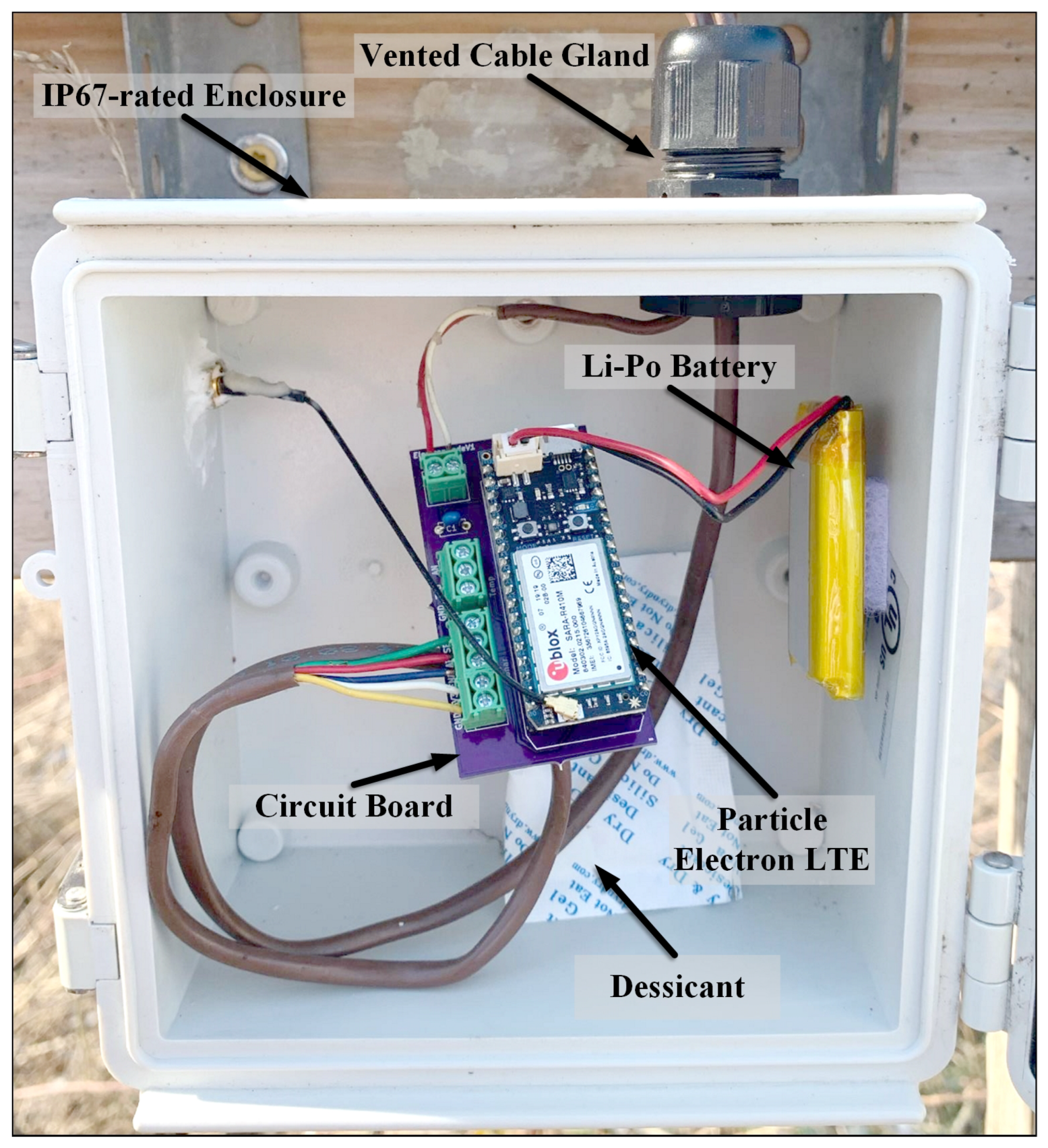
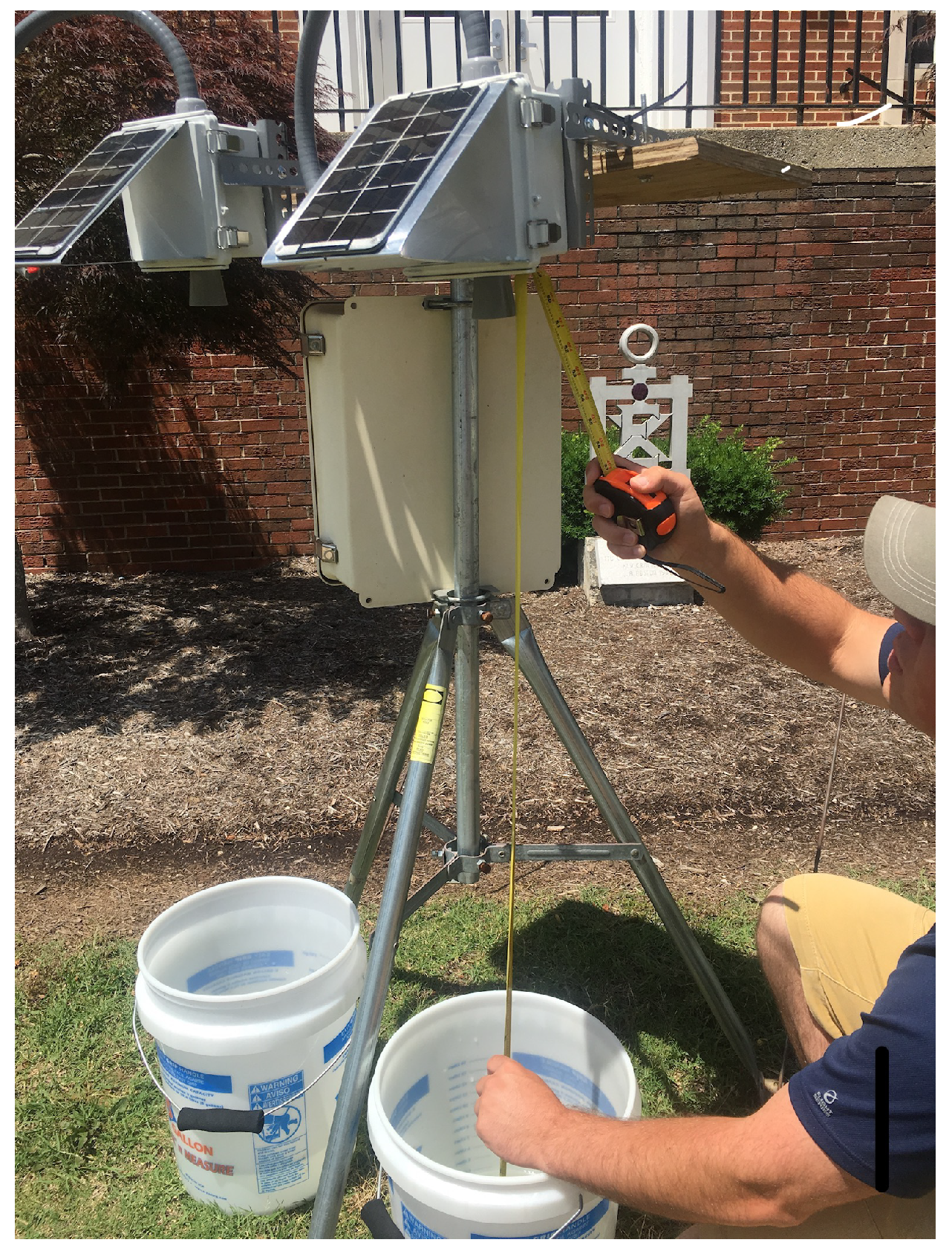
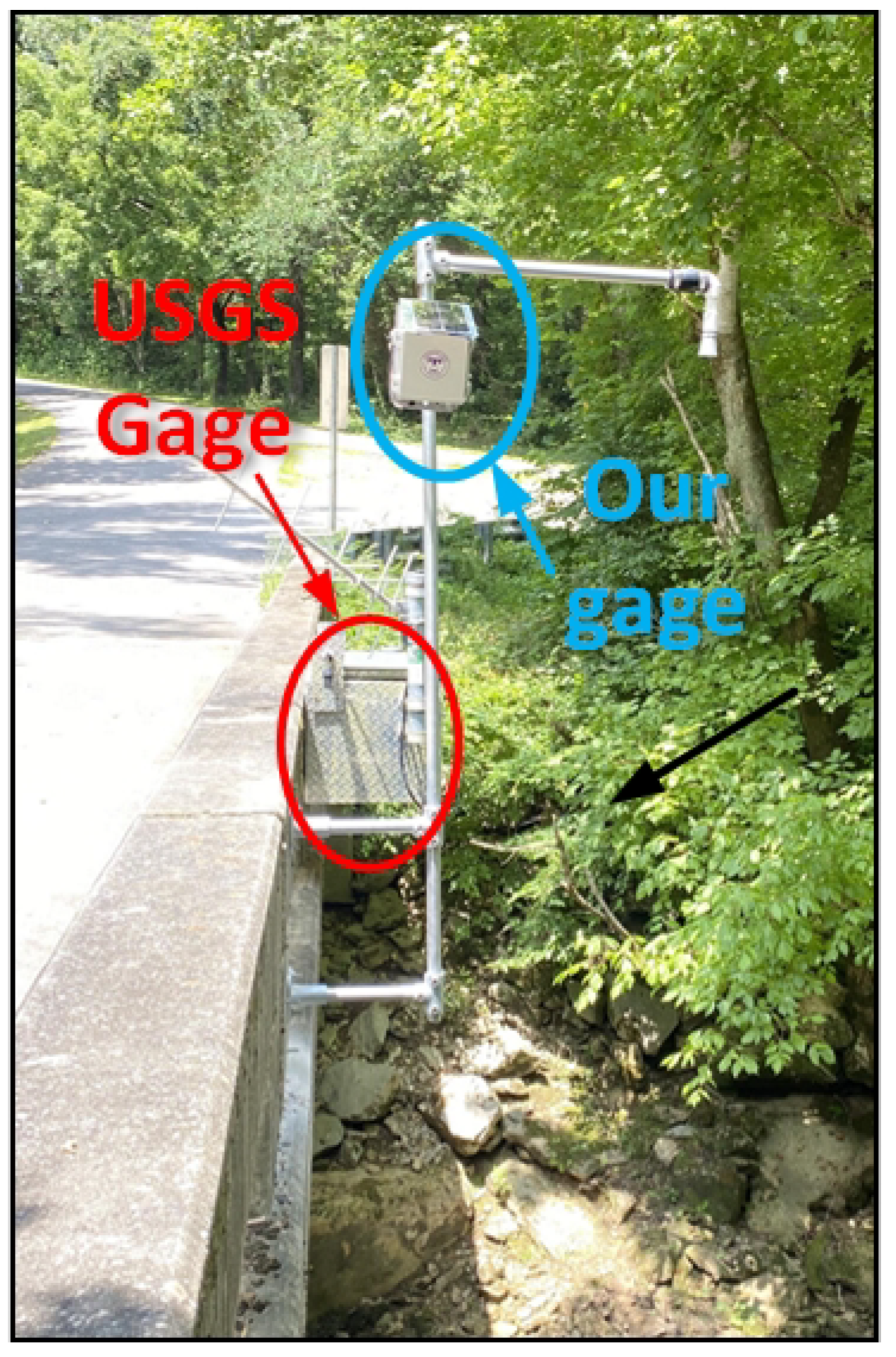
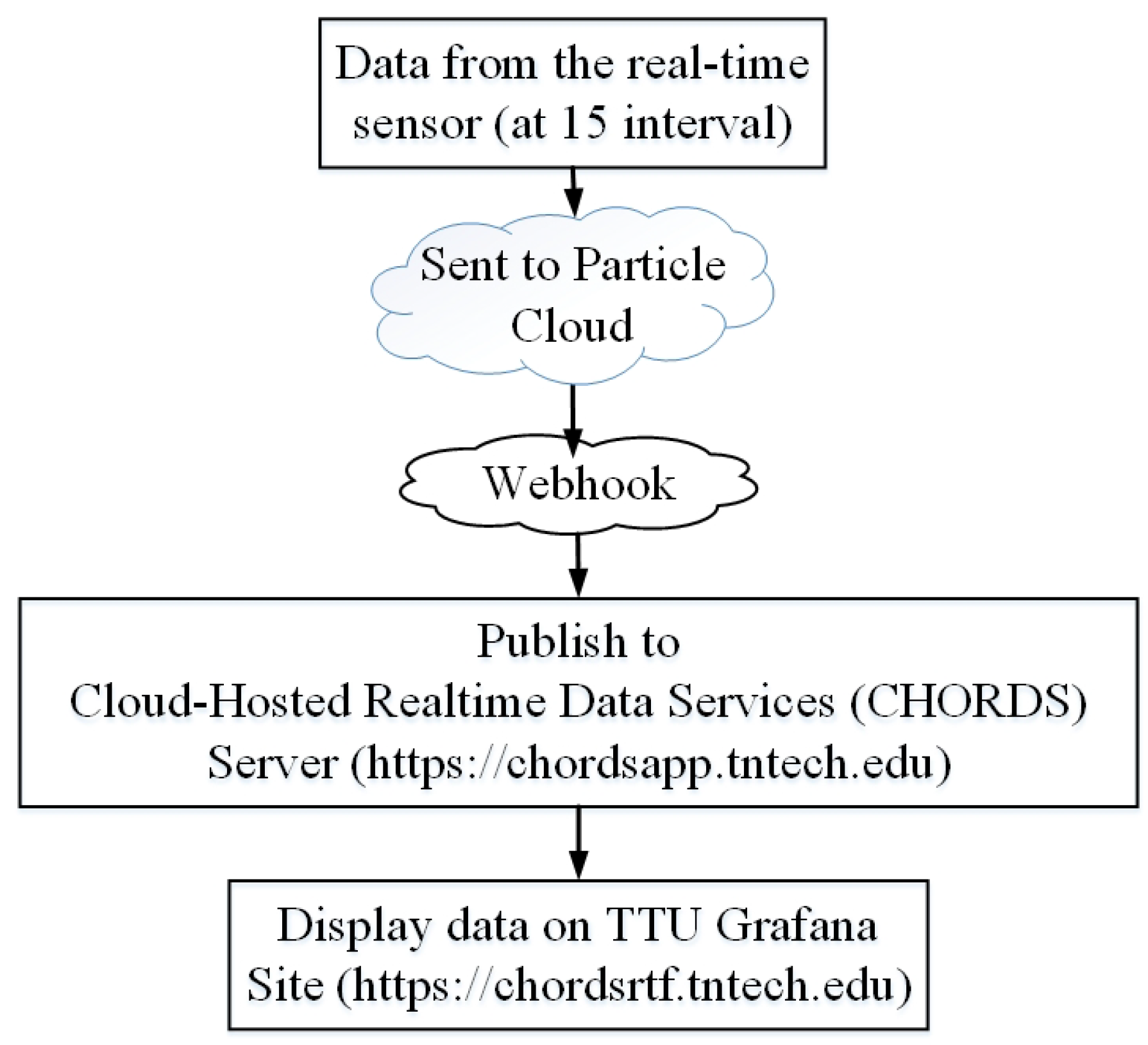
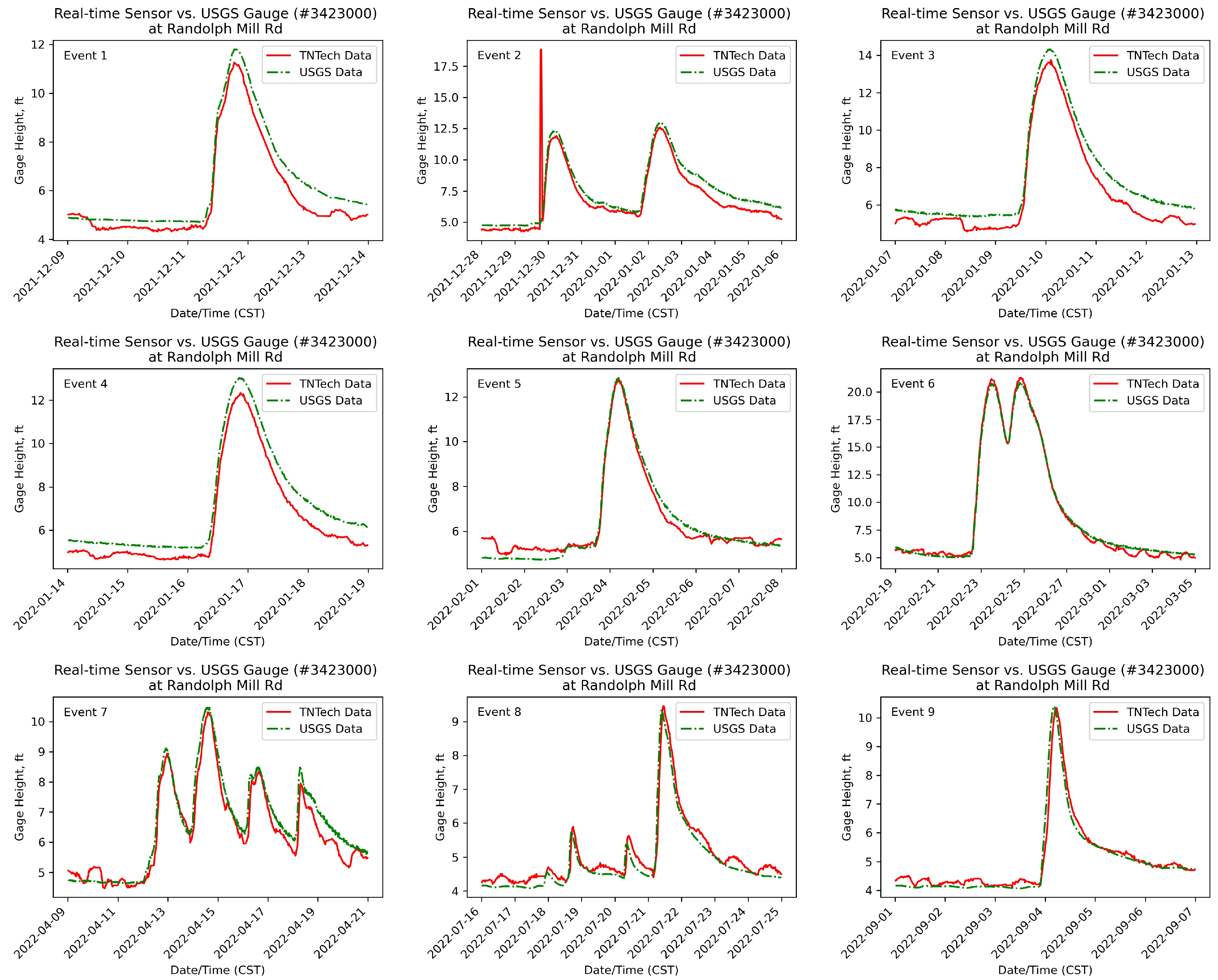
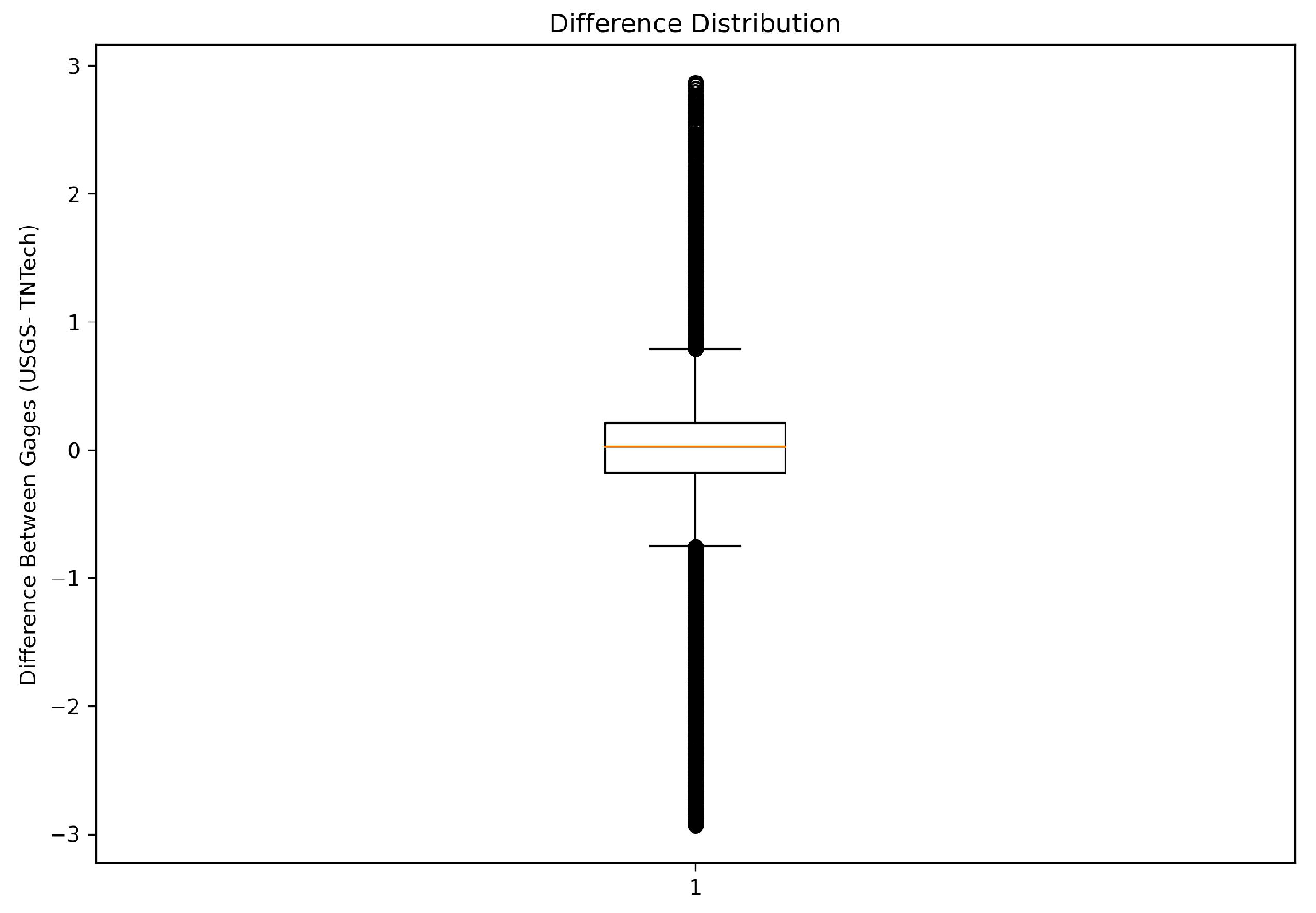
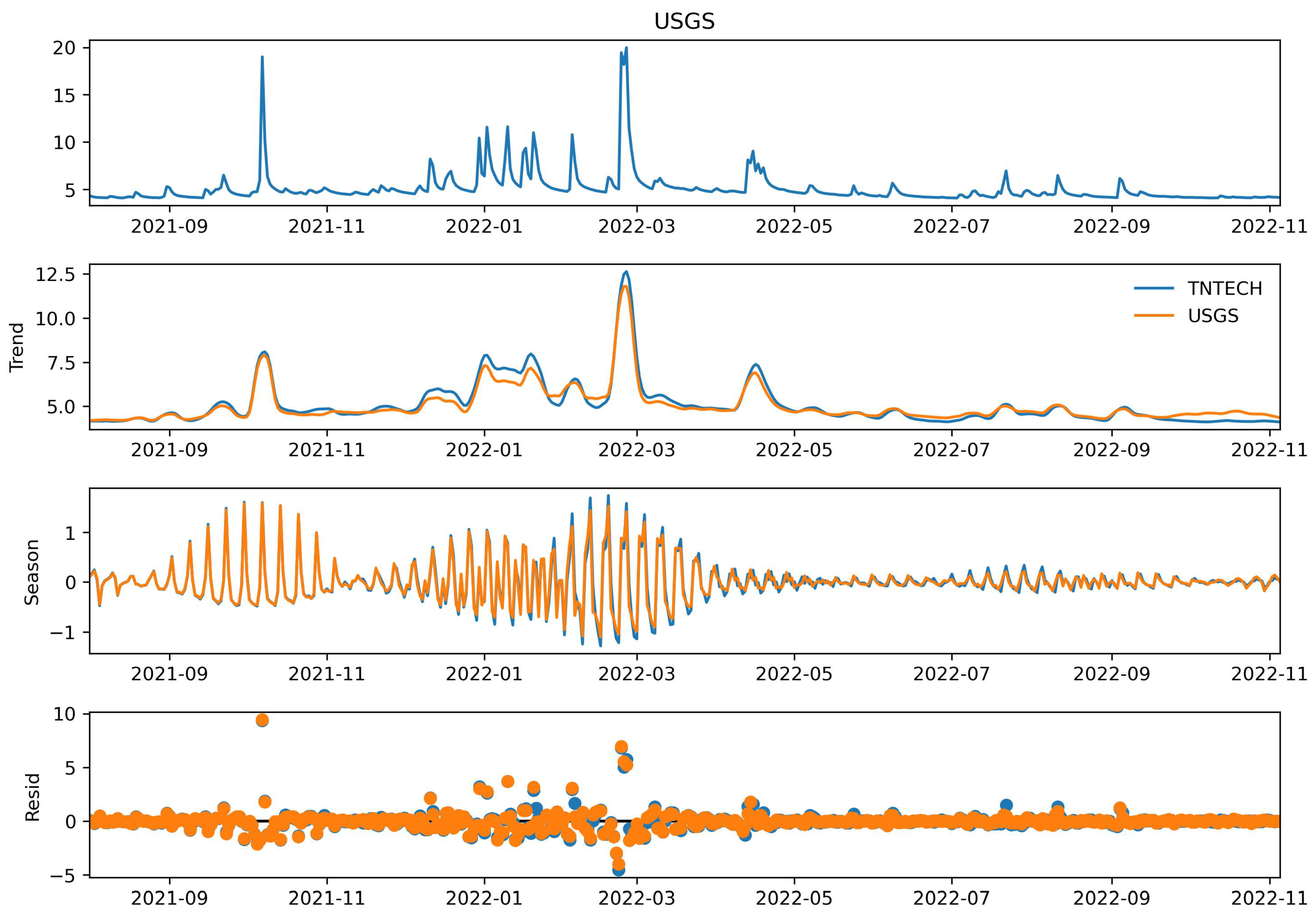
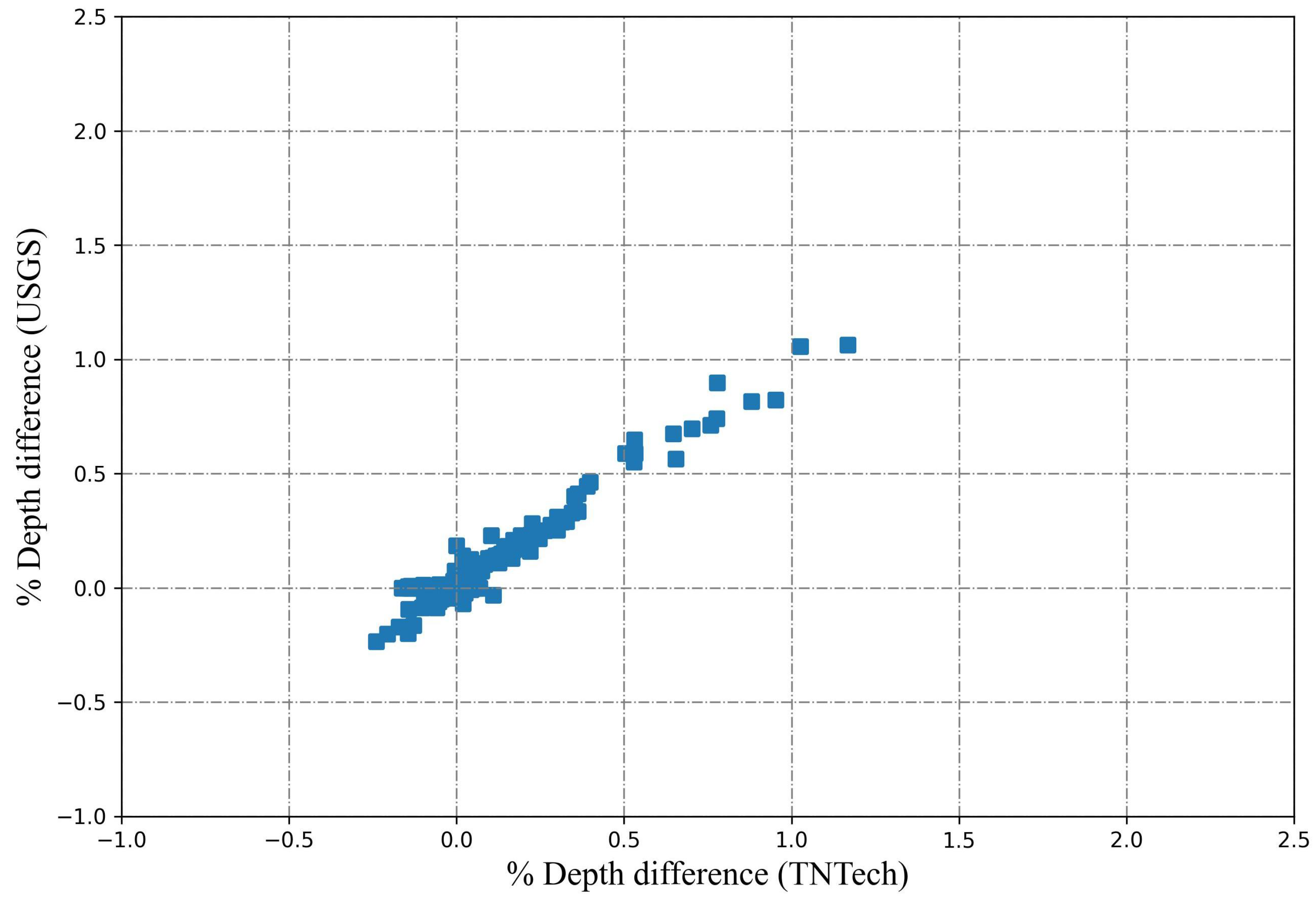
| Measure | Performance Evaluation Criteria | |||
|---|---|---|---|---|
| Very Good | Good | Satisfactory | Not Satisfactory | |
| Coefficient of Determination (R2) | ||||
| Nash–Suttcliffe Efficiency (NSE) | > 0.80 | |||
| PBIAS (%) | ||||
| MSE | Optimal Value is 0.0 | |||
| MAE | ||||
| RMSE | ||||
| Event Number | Time Period | Storm Depth (in.) |
|---|---|---|
| Event 1 | 12/9/2021 to 12/14/2021 | 1.26 |
| Event 2 | 12/28/2021 to 01/06/2022 | 3.67 |
| Event 3 | 01/7/2022 to 01/13/2022 | 1.54 |
| Event 4 | 01/14/2022 to 01/19/2022 | 3.45 |
| Event 5 | 02/01/2022 to 02/08/2022 | 1.75 |
| Event 6 | 02/19/2022 to 03/05/2022 | 5.7 |
| Event 7 | 04/09/2022 to 04/21/2022 | 4.7 |
| Event 8 | 07/16/2022 to 07/25/2022 | 2.03 |
| Event 9 | 09/01/2022 to 09/07/2022 | 3.18 |
| Event | R2 | NSE | PBIAS | MSE (ft2) | MAE (ft) | RMSE (ft) | |||
|---|---|---|---|---|---|---|---|---|---|
| Value | Performance | Value | Performance | Value | Performance | ||||
| Event 1 | 0.98 | Very Good | 0.94 | Very Good | 7.01 | Good | 0.26 | 0.45 | 0.51 |
| Event 2 | 0.87 | Very Good | 0.81 | Very Good | 6.80 | Good | 1.06 | 0.61 | 1.03 |
| Event 3 | 0.99 | Very Good | 0.92 | Very Good | 9.58 | Good | 0.57 | 0.71 | 0.75 |
| Event 4 | 0.99 | Very Good | 0.91 | Very Good | 9.53 | Good | 0.5 | 0.68 | 0.71 |
| Event 5 | 0.98 | Very Good | 0.97 | Very Good | −0.60 | Very Good | 0.12 | 0.28 | 0.35 |
| Event 6 | 1.00 | Very Good | 1.00 | Very Good | 0.31 | Very Good | 0.1 | 0.26 | 0.31 |
| Event 7 | 0.96 | Very Good | 0.94 | Very Good | 3.51 | Very Good | 0.15 | 0.31 | 0.39 |
| Event 8 | 0.97 | Very Good | 0.94 | Very Good | −3.56 | Very Good | 0.07 | 0.21 | 0.26 |
| Event 9 | 0.97 | Very Good | 0.96 | Very Good | −2.25 | Very Good | 0.07 | 0.17 | 0.27 |
Disclaimer/Publisher’s Note: The statements, opinions and data contained in all publications are solely those of the individual author(s) and contributor(s) and not of MDPI and/or the editor(s). MDPI and/or the editor(s) disclaim responsibility for any injury to people or property resulting from any ideas, methods, instructions or products referred to in the content. |
© 2023 by the authors. Licensee MDPI, Basel, Switzerland. This article is an open access article distributed under the terms and conditions of the Creative Commons Attribution (CC BY) license (https://creativecommons.org/licenses/by/4.0/).
Share and Cite
Kalyanapu, A.; Owusu, C.; Wright, T.; Datta, T. Low-Cost Real-Time Water Level Monitoring Network for Falling Water River Watershed: A Case Study. Geosciences 2023, 13, 65. https://doi.org/10.3390/geosciences13030065
Kalyanapu A, Owusu C, Wright T, Datta T. Low-Cost Real-Time Water Level Monitoring Network for Falling Water River Watershed: A Case Study. Geosciences. 2023; 13(3):65. https://doi.org/10.3390/geosciences13030065
Chicago/Turabian StyleKalyanapu, Alfred, Collins Owusu, Tyler Wright, and Tania Datta. 2023. "Low-Cost Real-Time Water Level Monitoring Network for Falling Water River Watershed: A Case Study" Geosciences 13, no. 3: 65. https://doi.org/10.3390/geosciences13030065
APA StyleKalyanapu, A., Owusu, C., Wright, T., & Datta, T. (2023). Low-Cost Real-Time Water Level Monitoring Network for Falling Water River Watershed: A Case Study. Geosciences, 13(3), 65. https://doi.org/10.3390/geosciences13030065









